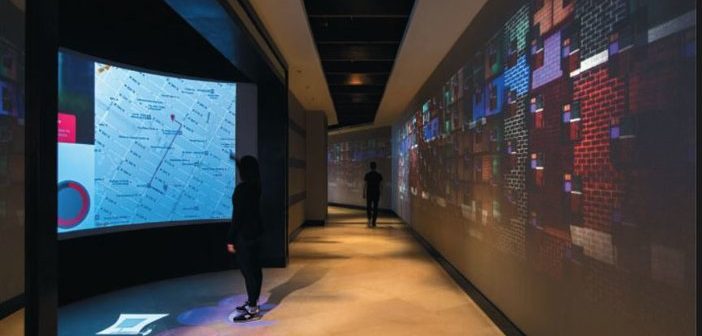Interactive displays, video walls, and smart lighting give hoteliers new tools to attract customers and improve branding
by Brad Grimes
Integrated audiovisual technologies are helping hoteliers reimagine the guest experience and exceed the expectations of the modern traveler. Touch-screens, high-definition content, and wireless connectivity are ubiquitous in daily life, and hoteliers are leveraging their popularity to deliver true value from lobbies to guest rooms.
According to Dave Kepron, vice president of Global Design at Marriott International, intelligent placement and use of digital technologies can greatly influence how guests perceive the brand and remember their stay.ntegrated audiovisual technologies are helping hoteliers reimagine the guest experience and exceed the expectations of the modern traveler. Touch-screens, high-definition content, and wireless connectivity are ubiquitous in daily life, and hoteliers are leveraging their popularity to deliver true value from lobbies to guest rooms.
“Architecture, design, materials, finishes, and furniture make up the physical environment,” Kepron says. “Digital pieces and the audiovisual overlay must be integrated into the overall design thinking. Providing digitally immersive audiovisual environments can engage and empower guests, making hotel stays more relevant and memorable.”
Placing Information at Guests’ Fingertips – Literally
Marriott’s Renaissance New York Midtown Hotel sets a high-tech tone before guests even enter, thanks to a four-story LED clock atop the building that changes every second, showing 86,400 images every day. The eclectic shapes and colors enhance the city skyline, while a replica clock located just above one of the hotel’s entrances mirrors the content in real time for guests to view up close.
Once inside, guests interact with digital artwork projected along the walls of a corridor that spans an entire city block. The display doesn’t change on its own. It uses 3D cameras, motion detectors, and reflective wallpaper to respond to human movements, creating an interactive wall that imbues guests with a unique high-tech vibe. It’s the kind of experience selfies were designed for.
The hotel also partnered with local New York lifestyle publication Time Out New York to launch the “Discovery Portal,” a digital concierge that allows guests to explore local sights and events in a fun and engaging way. Just beyond the interactive corridor, the hallway opens up to reveal a large curved display with graphical buttons projected on the ground in front of it.
Guests step on the buttons to select the time of day and distance they want to travel, which displays content showcasing local restaurants, live music, shopping, and more. Once it appears on the interactive screen, guests can access more in-depth information with just the point of a finger using the portal’s gesture-recognition technology.
According to Justin Etheridge, executive vice president of Time Out North America, the localized publication shares a common goal with the hotel: Help visitors experience the best local entertainment.
“The Discovery Portal Powered by Time Out is an evolution of that mission, an outstanding interactive feature for guests who want to ensure they make the most of their time in New York,” Etheridge says.
Taking Technology to the Guest Room
Most hotel lobbies and public spaces are incorporating advanced features like touchscreens for navigation, weather, and tourist information, but many hotels also are focusing on the in-room environment, recognizing that guests often want more than just a place to sleep.
“Our guests are saying that they want to connect their devices,” says Mari Balestrazzi, Hyatt Hotels vice president of design. “We want all of our televisions and sound systems in guest rooms to connect to your devices so that you can watch your own content and listen to your own music. We need to facilitate you having your own personalized space.”
At Hyatt’s Regency-branded locations, each room now includes a 65-inch HDTV, which Balestrazzi says received incredible feedback.
“Our guests are loving it,” she says. “They like watching whatever they brought with them, along with what’s available on cable. It feels like an all-encompassing experience. It makes the stay in the guest room feel a bit more special, with the same high-quality image and scale they have at home.”
Hyatt also is experimenting with tunable LED lighting in guest rooms and, with a focus on wellness, is studying the effects different hues can have on jet lag, circadian rhythm, and mood. Tunable white and color lighting also are on the rise in the hotel’s public spaces, especially in meeting rooms, whether programmed by the hotel or adjusted by guests.
“We found that customers really like the ability to change the color of the light in large ballrooms and meeting spaces because they can customize the experience for their event,” Balestrazzi says. “They can make colors that are on-brand for them.”
However, it’s not only the large hotels that are benefiting from integrated audiovisual experiences; boutique hotels that place a premium on design and style also are getting in on the AV action.
No Subtlety Here
At the Sofitel Paris Baltimore, a 19th-century townhouse hotel located near the Eiffel Tower in France, a recent renovation added a thrilling new guest experience: a 100-square-foot interactive “Welcome Wall” in the entrance hallway.
“Because they were renovating the hotel, the owners wanted to create something new and exciting that would make a statement every time a guest returns, and I think the digital Welcome Wall really achieves that goal,” says Alexandre Simionescu, managing partner and creative director of Float4, designers of the Welcome Wall.
“It’s not meant to be subtle. It’s meant to really attract attention and initiate interaction in a way that is not invasive. After their interest is piqued, guests notice that it’s interactive and are excited to actually touch the wall. The Welcome Wall is there to break the ice.”
The wall showcases playful artwork that responds to human movements, while also offering a photo booth and virtual concierge where guests can explore Paris with an interactive map. Any guests wishing to create a personalized walking tour can use the map, in coordination with hotel staff, to generate a two-hour long tour that can be downloaded onto smartphones and used as a guide through the city. The size of the wall attracts guests, the interactivity keeps them involved and excited, and offering useful technology instills positive memories of the hotel brand.
Looking to the Future
As consumers become more reliant on popular technologies, they will increasingly expect hotels they visit to provide the same, or better, experiences than they get at home. New technologies such as voice and mobile device control of in-room TVs, lights, and climate will give travelers a unique, memorable experience, and an opportunity to connect with the hotel’s unique branding.
Overall, the trend toward greater AV integration will continue to accelerate as new technologies allow hotel operators to incorporate more interactive, novel experiences. Hotels of all sizes will be able to improve the guest experience by simplifying wayfinding, information gathering, and check-in, while offering unique entertainment options.
Thanks to the illumination and engagement afforded by today’s cutting-edge audiovisual technologies, the future of the hotel industry has never been brighter.
About the author
Brad Grimes is senior director of communications for AVIXA™, the Audiovisual and Integrated Experience Association. AVIXA represents the $178 billion global commercial AV industry and produces InfoComm trade shows around the world. For more information, visit www.avixa.org/hospitalityAV.




